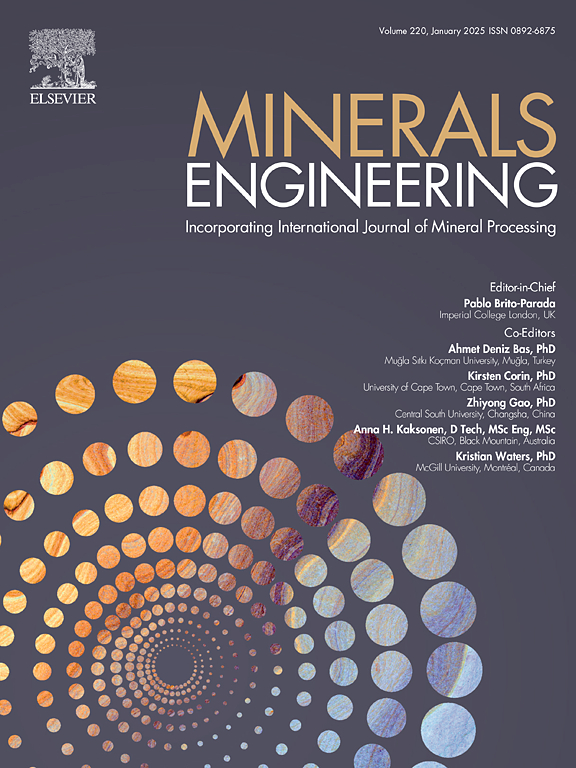Selective depression of galena by tamarind seed gum during chalcopyrite flotation
IF 4.9
2区 工程技术
Q1 ENGINEERING, CHEMICAL
引用次数: 0
Abstract
The similar flotation properties of chalcopyrite and galena pose significant challenges for their flotation separation. To address this, tamarind seed gum (TSG) was evaluated as an galena depressant with butyl xanthate (BX) as the collector in the flotation separation of chalcopyrite and galena. The depression mechanism of TSG on galena was investigated through flotation tests, contact angle measurements, zeta potential measurements, X-ray photoelectron spectroscopy (XPS) analyses, inductively coupled plasma optical emission spectrometer (ICP-OES) tests, Atomic force microscopy (AFM) tests and density functional theory (DFT) calculations. The flotation tests demonstrated that TSG had strong depression effect on galena under neutral condition. However, it slightly affected chalcopyrite flotation. The adsorption of TSG on the galena surface was confirmed through contact angle measurements, zeta potential measurements, XPS analyses. The ICP-OES tests revealed that TSG impeded the dissolution of Pb2+ and improved its hydrophilicity. AFM tests demonstrated a pronounced augmentation in the adsorption affinity of TSG towards the galena surface as opposed to chalcopyrite, consequently hindering subsequent collector attachment onto galena. Density Functional Theory (DFT) calculations indicated the active hydroxyl groups in the polysaccharide structure of TSG have a strong interaction with lead hydroxide of galena surface, while exhibiting very low affinity for the lead hydroxide of galena surface. This study provides a theoretical basis for using TSG as an galena depressant in the flotation separation of galena from chalcopyrite.

罗望子胶对黄铜矿浮选过程中方铅矿的选择性抑制
黄铜矿与方铅矿具有相似的浮选特性,这给它们的浮选分离带来了很大的挑战。为了解决这一问题,研究了罗望子胶(TSG)作为方铅矿抑制剂与丁基黄药(BX)作为捕收剂在黄铜矿和方铅矿浮选分离中的应用。通过浮选试验、接触角测量、zeta电位测量、x射线光电子能谱(XPS)分析、电感耦合等离子体发射光谱仪(ICP-OES)测试、原子力显微镜(AFM)测试和密度泛函理论(DFT)计算,研究了TSG对方铅矿的抑制机理。浮选试验表明,TSG在中性条件下对方铅矿有较强的抑制作用。但对黄铜矿浮选影响较小。通过接触角测量、zeta电位测量和XPS分析,证实了TSG在方铅矿表面的吸附作用。ICP-OES实验表明,TSG抑制了Pb2+的溶解,提高了其亲水性。AFM测试表明,与黄铜矿相比,TSG对方铅矿表面的吸附亲和力明显增强,从而阻碍了随后的捕收剂附着在方铅矿上。密度泛函理论(DFT)计算表明,TSG多糖结构中的活性羟基与方铅矿表面的氢氧化铅有很强的相互作用,而对方铅矿表面的氢氧化铅具有很低的亲和力。本研究为利用TSG作为方铅矿抑制剂浮选分离黄铜矿中方铅矿提供了理论依据。
本文章由计算机程序翻译,如有差异,请以英文原文为准。
求助全文
约1分钟内获得全文
求助全文
来源期刊

Minerals Engineering
工程技术-工程:化工
CiteScore
8.70
自引率
18.80%
发文量
519
审稿时长
81 days
期刊介绍:
The purpose of the journal is to provide for the rapid publication of topical papers featuring the latest developments in the allied fields of mineral processing and extractive metallurgy. Its wide ranging coverage of research and practical (operating) topics includes physical separation methods, such as comminution, flotation concentration and dewatering, chemical methods such as bio-, hydro-, and electro-metallurgy, analytical techniques, process control, simulation and instrumentation, and mineralogical aspects of processing. Environmental issues, particularly those pertaining to sustainable development, will also be strongly covered.
 求助内容:
求助内容: 应助结果提醒方式:
应助结果提醒方式:


